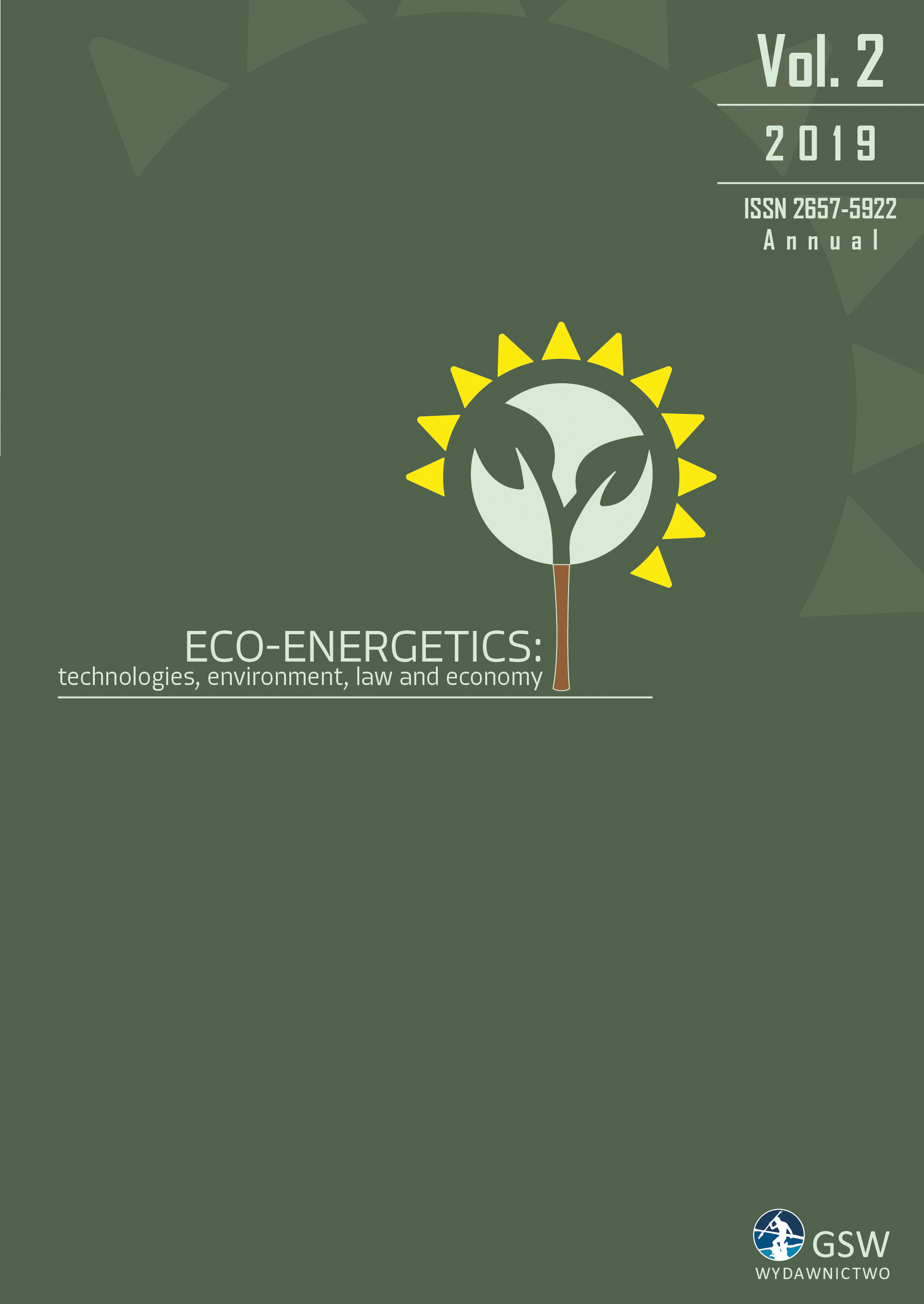Characteristic of tar content and syngas composition during beech updraft gasification
DOI:
https://doi.org/10.24426/eco-energetics.v2i2.110Słowa kluczowe:
gasification tar, updraft gasifier, beech wood, GC-MS spectrometryAbstrakt
This work aims at study the effect of the operating conditions like equivalence ration and temperature on the updraft gasification of beech wood. The main aspects was to analyze the influence of temperature distribution in the reactor and equivalence ratio on the fuel consumption, syngas composition as well as tar formation characteristics during the gasification process. The light tar content and composition were analysed using gas chromatography coupled with mass spectrometry (GC-MS). Experimental results have shown that the amount of air supplied does not affect the parameters of the gasification process linearly. For lower ER value there was high fuel consumption and high bed temperature in the gasifier, which results in high caloric value of syngas. The results showed that tar yield during updraft gasification depends on the temperature and equivalence ratio. With the increase value of ER and the decrease of temperature on the surface of the bed, the total amount of tar yield increased. The highest temperature on the surface of the bed leads to the smallest tar yield, which can be associated with thermal cracking. The results indicate that both light and heavy tar are changing nonlinearly with different operating conditions. In addition, with decreasing temperature and increasing ER values, the amount of phenol and oxidized aliphatic compounds in the tar samples increased while the BTEX amount decreased. The amount of PAHs, in relation to the temperature and ER, was kept low in all cases.
Bibliografia
Chen, W., Annamalai, K., Ansley, R.J., Mirik, M. (2012). Updraft fixed bed gasification of mesquite and juniper wood samples. Energy, 41, 454–461.
Custodis, V.B.F., Bährle, C., Vogel, F., Bokhoven van, J.A. (2015). Phenols and aromatics from fast pyrolysis of variously prepared lignins from hard- and softwoods. J Anal Appl Pyrol, 115, 214–223.
Demirbas, A. (2005), Pyrolysis of ground beech wood in irregular heating rate conditions. J Anal Appl Pyrol, 73, 39–43.
Devi, L., Ptasinski, K.J., Janssen, F.J.J.G. (2003). A review of the primary measures for tar elimination in biomass gasi cation processes. Biomass Bioenerg, 24, 125–140.
Edinger, P., Schneebeli, J., Struis, R.P.W.J., Biollaz, S.M.A., Ludwig, C. (2016). On-line liquid quench sampling and UV-Vis spectroscopy for tar measurements in wood gasification process gases. Fuel, 184, 59–68.
Erlich, C., Fransson, T.H. (2011). Downdraft gasification of pellets made of wood, palm-oil residues respective bagasse: Experimental study. Appl Energ, 88, 899–908.
Good, J., Ventress, L., Knoef, H., Zielke, U., Lyck Hansen, P., Van de Kamp, W., De Wild, P., Coda, B., Paasen van, S., Kiel J., Sjöström, K., Liliedahl, T., Umger, Ch., Neeft, J., Suomalainen, M., Simell, P. (2005). Sampling and analysis of tar and particles in biomass producer gases, Technical Report. BTG biomass technology group, Prepared under: CEN BT/TF 143 “Organic contaminants (“tar”) in biomass producer gases”.
Hernández, J.J., Ballesteros, R., Aranda, G. (2013). Characterisation of tars from biomass gasification: Effect of the operating conditions. Energy, 50, 333–342.
Ismail, T.M., El-Sala, M.A. (2017). Parametric studies on biomass gasification process on updraft gasifier high temperature air gasification. Appl Therm Eng, 112, 1460–1473.
Kawamoto, H., Murayama, M., Saka, S. (2003). Pyrolysis behavior of levoglucosan as an intermediate in cellulose pyrolysis: polymerization into polysaccharide as a key reaction to carbonized product formation. J Wood Sci, 49, 469–473.
Kihedu, J.H., Yoshiie, R., Naruse, I. (2016). Performance indicators for air and air-steam auto-thermal updraft gasification of biomass in packed bed reactor. Fuel Process Technol, 141, 93–98.
Li, C., Suzuki, K. (2009). Tar property, analysis, reforming mechanism and model for biomass gasification — an overview. Renew Sust Energ Rev, 13, 594–604.
Ma, Z., Zhang, Y., Zhang, Q., Qu, Y., Zhou, J., Qin, H. (2012). Design and experimental investigation of a 190 kWe biomass fixed bed gasification and polygeneration pilot plant using a double air stage downdraft approach. Energy, 46, 140–147.
Mani, T., Mahinpey, N., Murugan, P. (2011). Reaction kinetics and mass transfer studies of biomass char gasification with CO2. Chem Eng Sci, 66, 36–41.
McKendry, P. (2002). Energy production from biomass (part 3): gasification technologies. Bioresource Technol, 83, 55–63.
Nakamura, S., Siriwat, U., Yoshikawa, K., Kitano, S. (2015). Development of Tar Removal Technologies for Biomass Gasification using the By-products. Energy Procedia, 75, 208–213.
Nowakowski, D.J., Bridgwater, A.V., Elliott, D.C., Meier, D., Wild de, P. (2010). Lignin fast pyrolysis: Results from an international collaboration. J Anal Appl Pyrol, 88, 53–72.
Pedroso, D.T., Machín, E.B., Silveira, J.S., Nemoto, Y. (2013). Experimental study of bottom feed updraft gasifier. Renew Energ, 57, 311–316.
Phuphuakrat, T., Nipattummakul, N., Namioka, T., Kerdsuwan, S., Yoshikawa, K. (2010). Characterization of tar content in the syngas produced in a downdraft type fixed bed gasification system from dried sewage sludge. Fuel, 89, 2278–2284.
Sircar, I., Sane, A., Wang, W., Gore, J.P. (2014). Experimental and modeling study of pinewood char gasification with CO2. Fuel, 119, 38–46.
Thanapal, S.S. (2010). Gasification of low ash partially composted dairy biomass with enriched air mixture (Master thesis). Texas: A&M University.
Yang, H., Yan, R., Chen, H., Lee, D.H., Zheng, C. (2007). Characteristics of hemicellulose, cellulose and lignin pyrolysis. Fuel, 86, 1781–1788.
Yu, H., Zhang, Z., Li, Z., Chen, D. (2014). Characteristics of tar formation during cellulose, hemicellulose and lignin gasification. Fuel, 118, 250–256.
Zhang, X., Yang, W., Blasiak, W. (2012). Thermal decomposition mechanism of levoglucosan during cellulose pyrolysis. J Anal Appl Pyrol, 96, 110–119.

